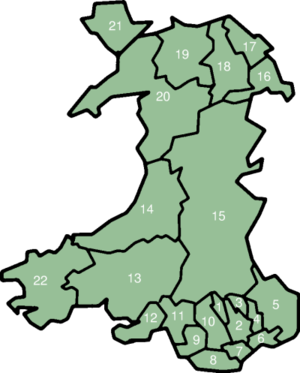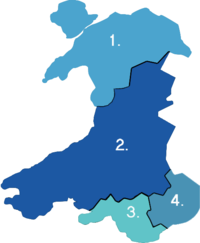Local government in Wales
2008/9 Schools Wikipedia Selection. Related subjects: UK Politics & government
For local government purposes, Wales is divided into 22 unitary authorities. There are nine counties, three cities1, and ten county boroughs, although all have equal powers. Collectively these are known as the principal areas of Wales. They came into being on April 1, 1996 by virtue of the Local Government (Wales) Act 1994 (1994 c. 19).
Principal areas of Wales
Areas are Counties, unless marked * (for Cities) or † (for County Boroughs). Welsh language forms are given in parentheses, where they differ from the English.
 |
|
|
||||||||||||||||||||||||||||||||||
Name changes
The current names of certain principal areas are different from those specified in the Local Government (Wales) Act 1994. The following changes took place, all with effect from April 2, 1996 :
- Conwy from Aberconwy and Colwyn
- Isle of Anglesey from Anglesey
- Gwynedd from Caernarfonshire and Merionethshire
- Ceredigion from Cardiganshire
- Neath Port Talbot from Neath and Port Talbot
Communities
The lowest level of subdivision below principal areas are Communities. Each Welsh principal area is subdivided into communities. They have elected community councils (CCs) which perform a number of roles, such as providing local facilities, and representing their communities to larger local government bodies. Community councils are the equivalent of English parish councils. A community council may call itself a 'town council' if it wishes to do so. Two Welsh communities Bangor and St David's have city status and are therefore called 'City Councils'. Communities which are too small to have a council have a community meeting instead, an example of direct democracy.
Police and fire services
Police forces
There are four police forces in Wales. These are:
 |
|
Fire and rescue services
There are three fire and rescue services in Wales. The present Welsh fire services date from 1996. Each covers a number of principal areas. These are:
